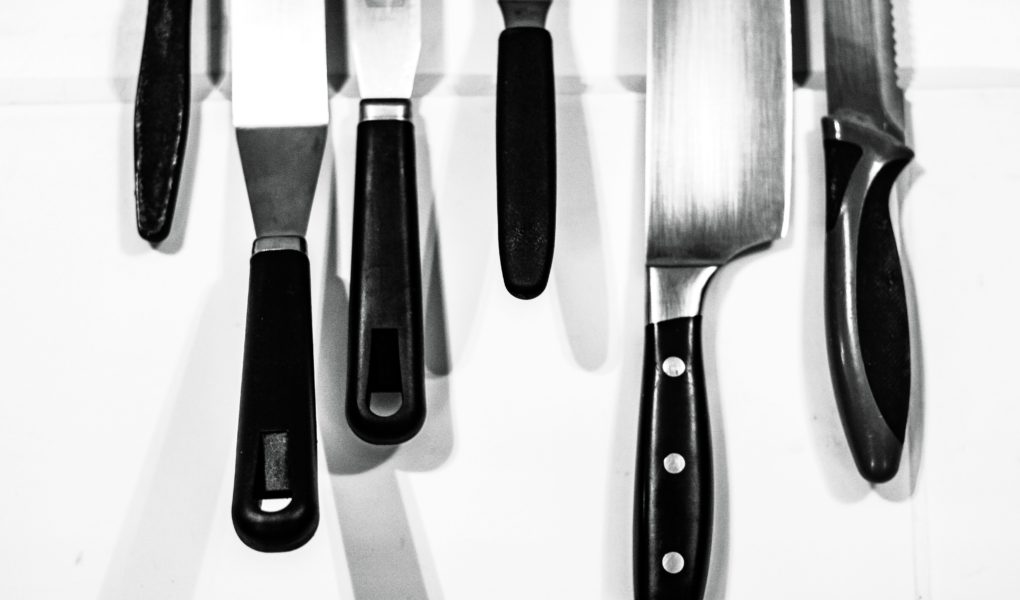Of all the different kitchen tools and gadgets, knives are the most indispensable ones.
But do you know that there are different knives for various purposes? Although you can use them interchangeably, each type of knife is designed for specific needs. So, your work will be faster and more efficient when you choose the right blade for the task.
Chef’s Knife

If there is one type of knife that every kitchen should have, it is a chef’s knife. A chef’s knife is very easy to hold and work with. This handy knife is made of highly durable and corrosion-resistant steel or ceramic. It will be 8 to 10 inches long with a rounded tip. You can use it to cut, chop, and slice vegetables, fruits, meat, fish, and poultry. While this knife is suitable for most kitchen tasks, avoid using it to peel fruits and vegetables. Due to its larger size, the blade may slip and cause injuries.
Santoku Knife

The Santoku knife is another general-purpose knife, like the chef’s knife. However, it has a thinner Japanese blade and a different shape. Although the blade is more delicate, it is sturdy and hard. Hence, you can adeptly use it for precision tasks.
You can use the Santoku knife for the same activities as a chef’s knife, like slicing, dicing, and mincing. Additionally, you can also use it for any of the following:
- Chopping and mincing meat
- Slicing, cheese, fruits, vegetables, and nuts
- Mincing herbs
- Fine slicing of vegetables, fruits, and seafood
Carving Knife

A carving knife is thinner and narrower than a chef’s knife. It has a very sharp blade. The unique shape of this knife is adeptly suited for accurate and clean cutting.
Apart from using a carving knife to slice vegetables and fruits, people can also use it to slice large cuts of beef, pork, or roasted turkey. However, it is not suitable for chopping.
Bread Knife

Bread knives have long, serrated edges resembling saws’ cutting edges. This knife should be moved in the same back-and-forth manner as you would use a saw for cutting things. It will allow you to slice through bread and carve it without leaving crumbs.
You can also use a bread knife to cut cakes, other baked goods, and chocolate. You can even use it to slice tomatoes and melons, which are difficult to cut with straight blades.
Utility Knife

As the name suggests, utility knives are very versatile devices. They are larger than paring knives but smaller than chef’s knives. The convenient size makes them the best choice for slicing and chopping vegetables and medium cuts of meat.
Utility knives may have straight or serrated blades. Serrated utility knives are useful for slicing bread or sandwiches. You can use utility knives with straight blades for various purposes, including peeling produce.
Paring Knives

Paring knives can handle almost any cutting task with utmost precision. Although they are smaller than other knives, paring knives are versatile and efficient.
Paring knives have very sharp blades with serrated or straight edges. You can use them to peel, chop, slice, mince, and even deseed fruits and vegetables. These knives are suitable for almost anything in the kitchen except for cutting large pieces of meat or vegetables.
Meat Cleaver

The meat cleaver is a heavy-duty knife with a strong, sharp, rectangular blade. While you can use it for various tasks, the primary function of a meat cleaver is to cut through bone. Apart from using it to chop and slice meat, you can also use it to cut vegetables, fruits, and pretty much any produce.
Many chefs use the heavy flat side of the meat cleaver to crush garlic cloves, making it easier to mince. Meat cleavers are available in various sizes. Since these devices are heavy, choose one that you can comfortably hold. It can be pretty dangerous if not used properly. So, ensure you have a steady grip on these knives to avoid accidents.
To wrap it up….
Before you buy a set of specialist knives, understand the purpose and intention of each type of knife. Arm yourself with the right knowledge and the right tool, and your culinary experiments will be more exciting and efficient.





